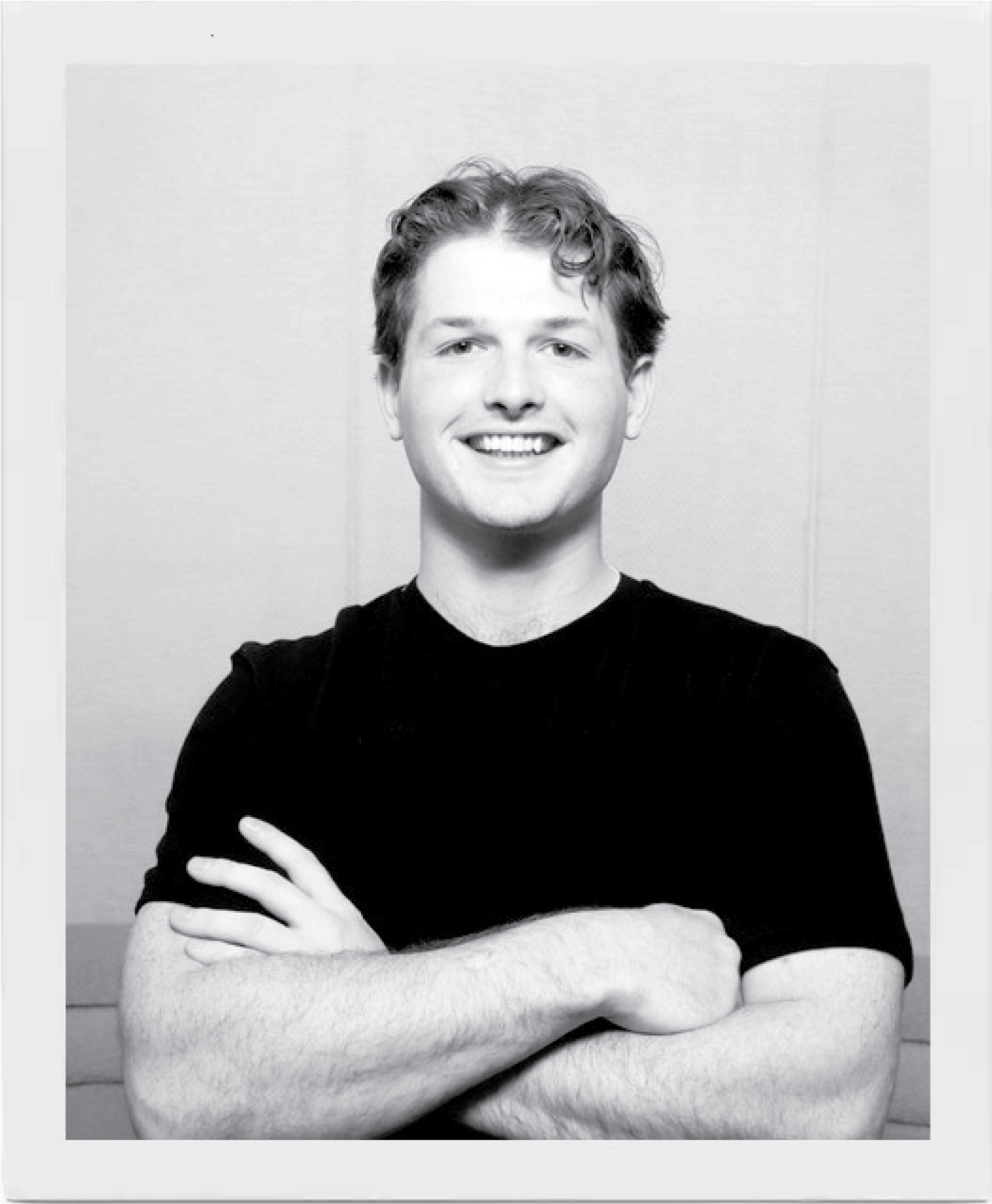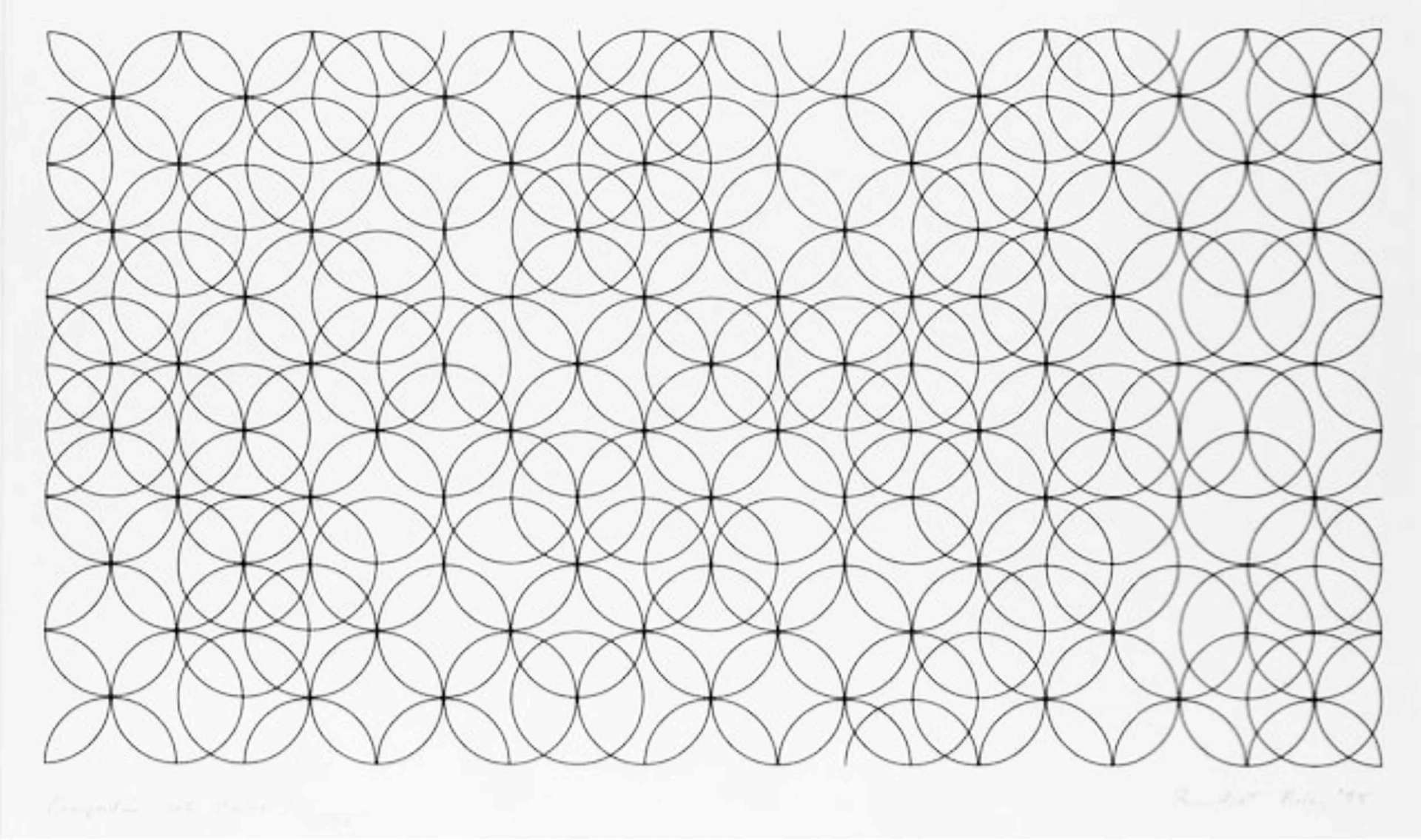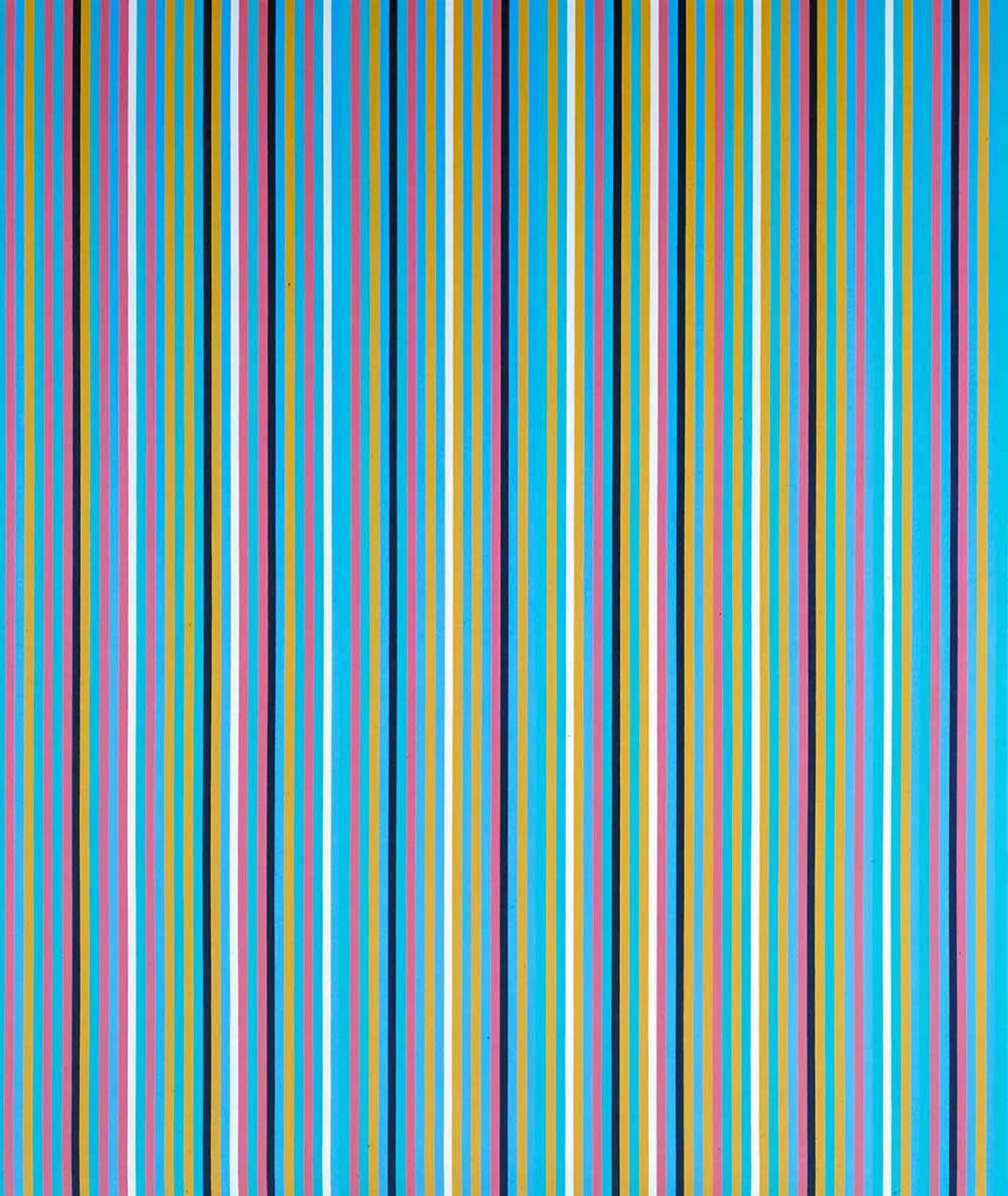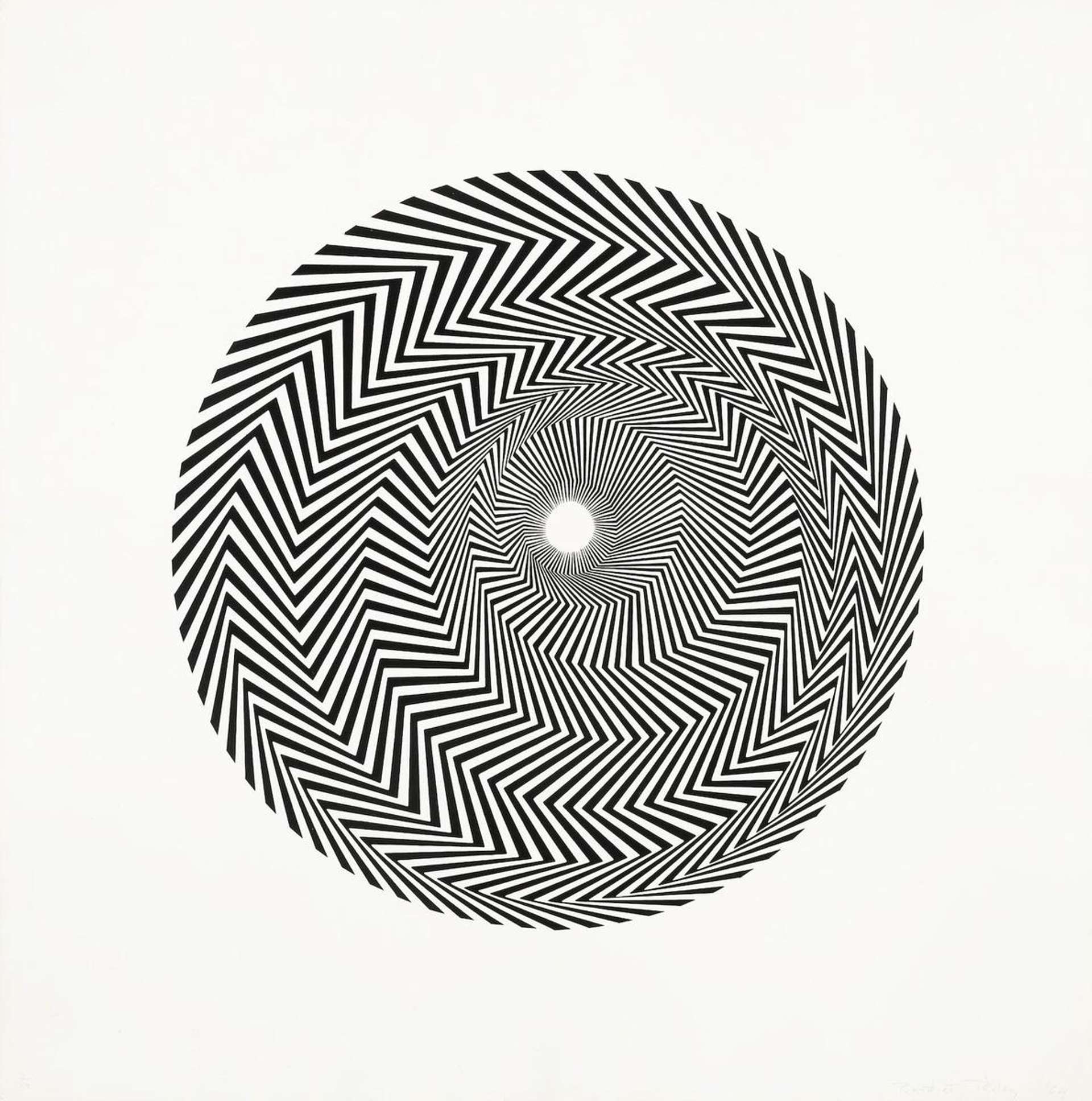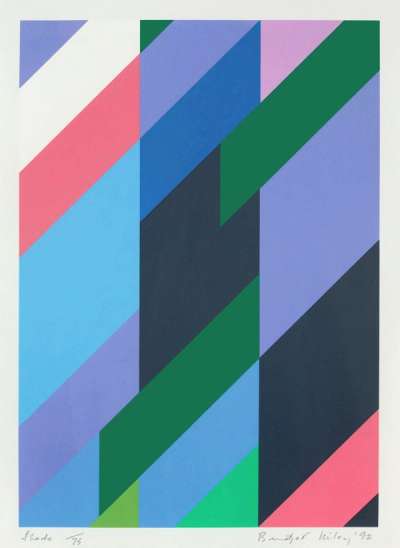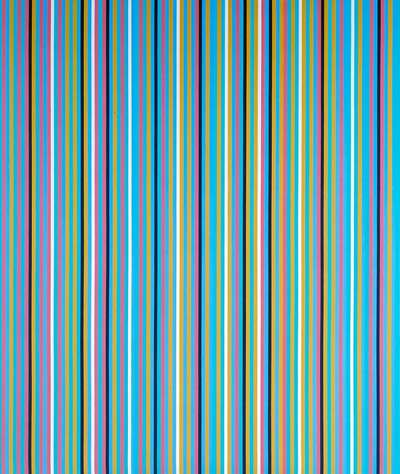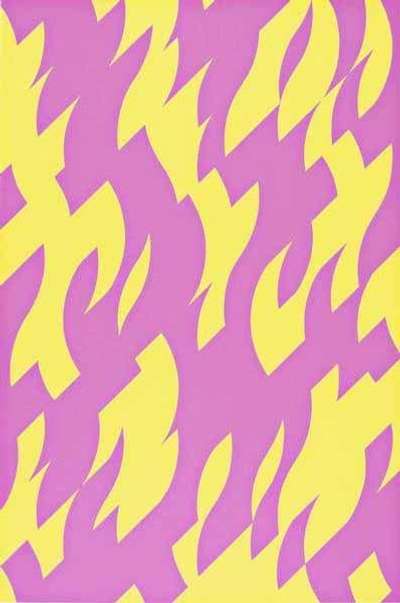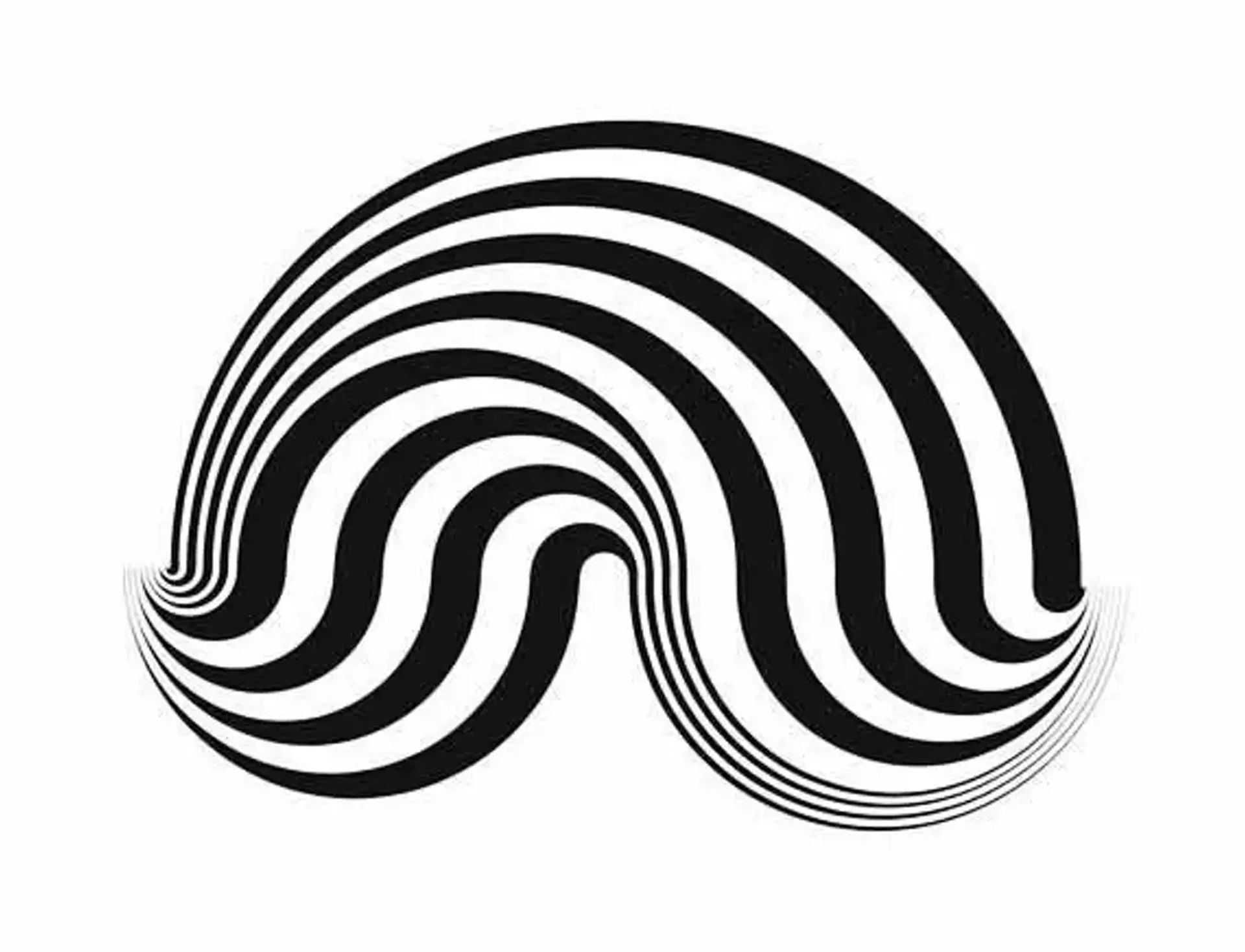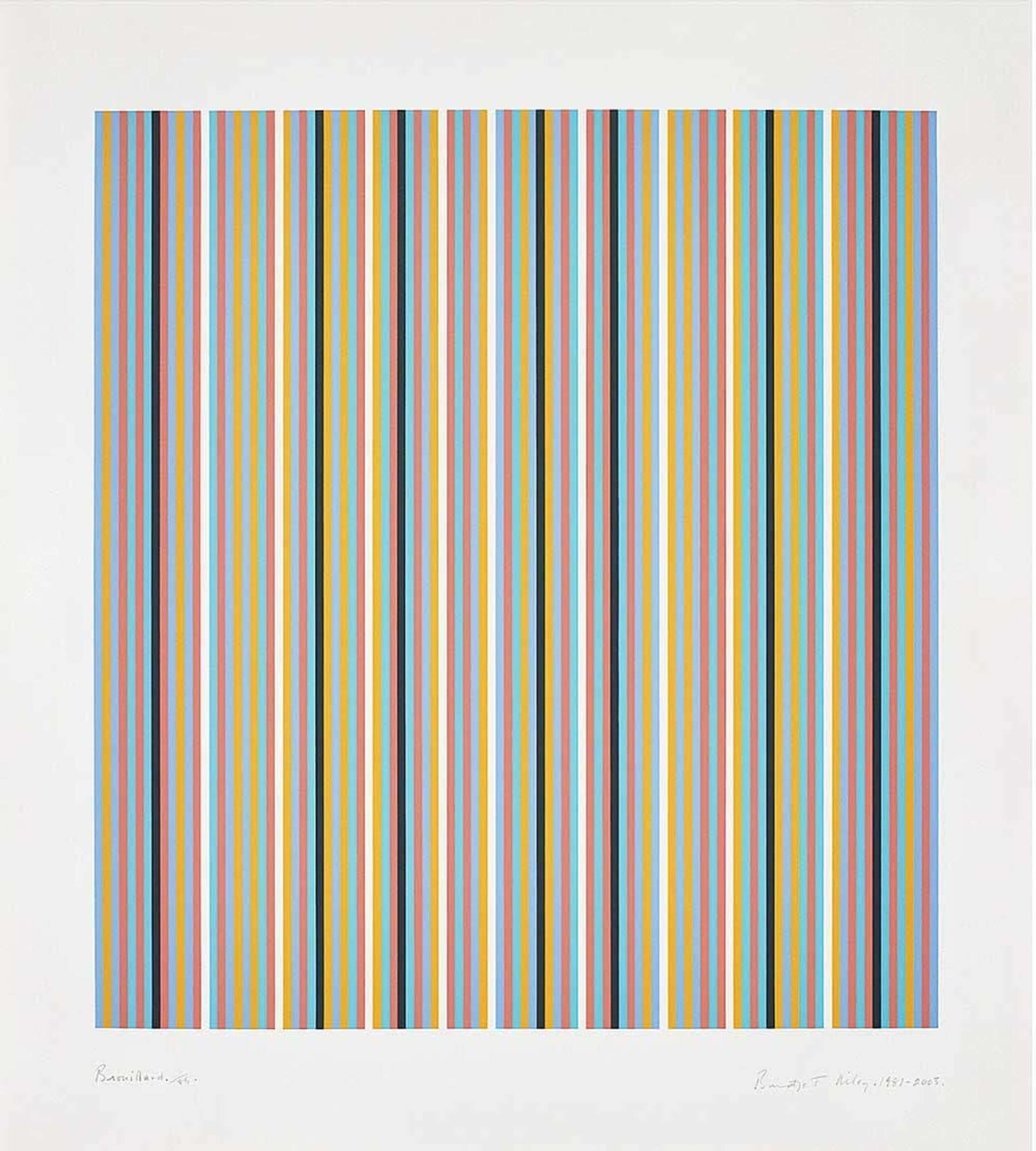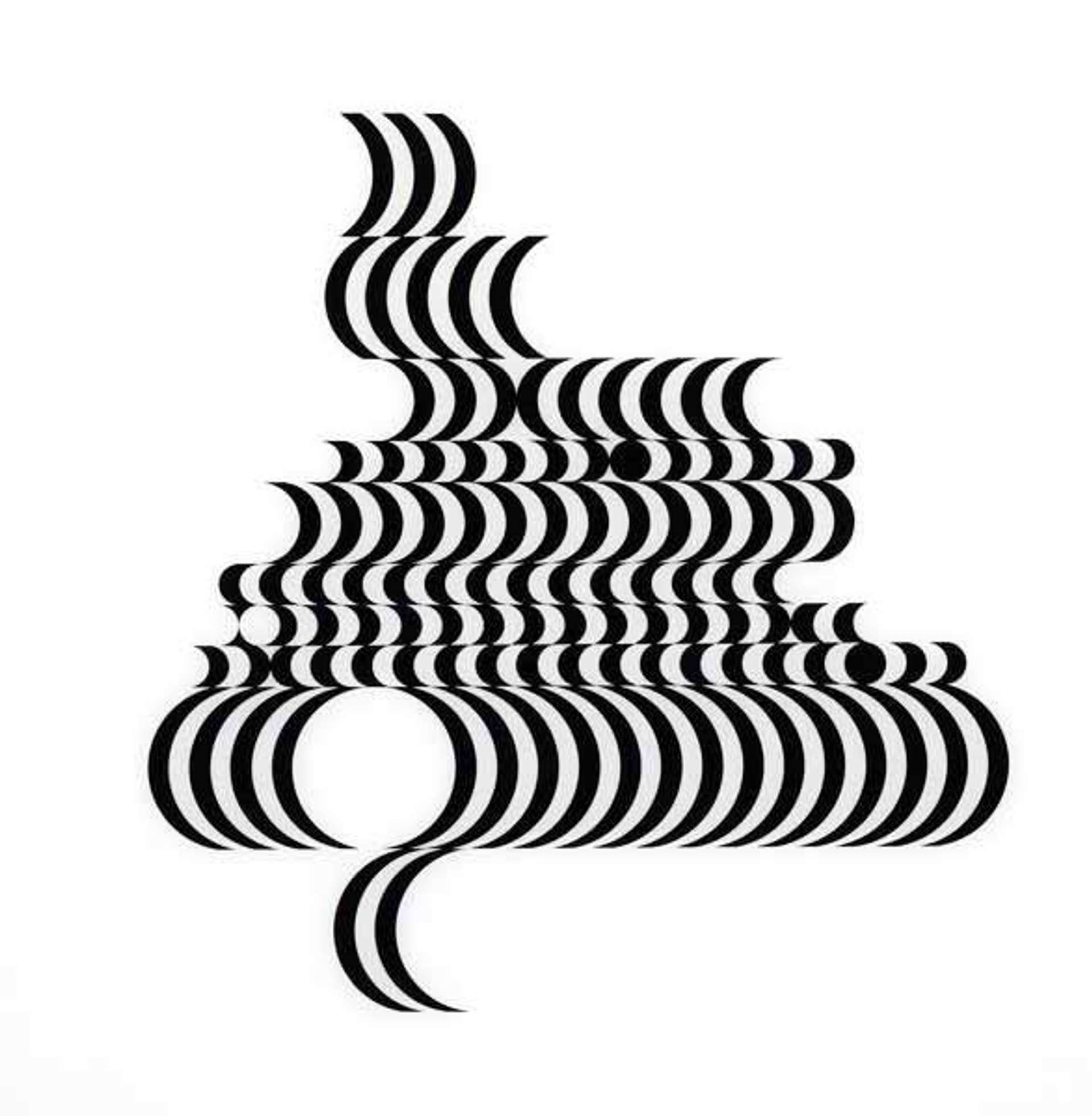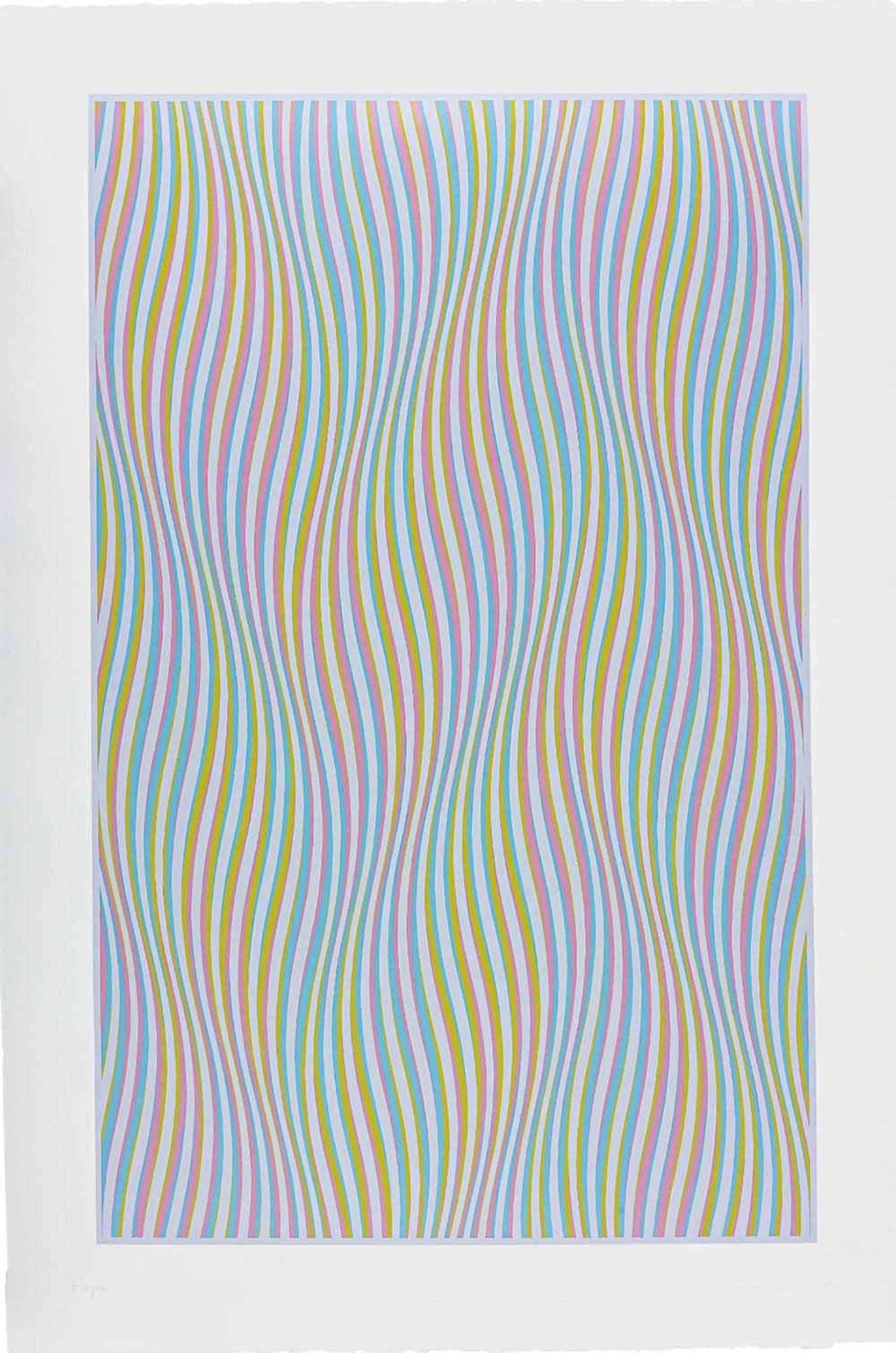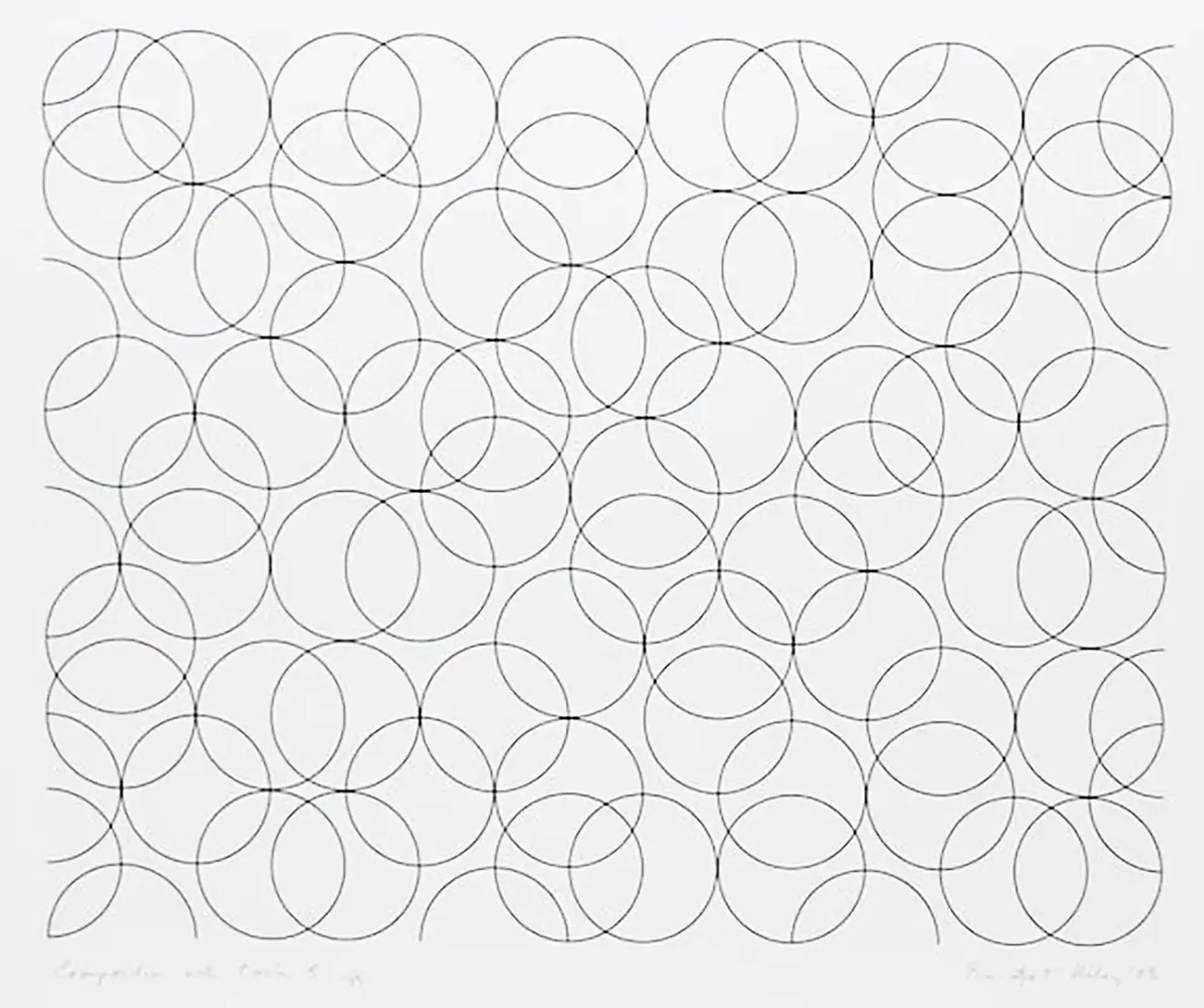 Bagatelle 3 © Bridget Riley 2015
Bagatelle 3 © Bridget Riley 2015Playing a crucial role in the development of the Optical Art Movement during the 1960s, and continuing to be an influential figure today, Bridget Riley is one of the most significant figures in the history of art. Greatly celebrated, she is a puppeteer of perception through her innovative use of pattern and repetition in her work.
Why Bridget Riley’s Art Matters In History
Riley's contribution to the art world is incredibly significant, as the field of Optical Art was revolutionised by the use of repetition and pattern in her works. Riley’s pieces are known for challenging the traditional notions of perception, and creating visual movement and depth that encapsulates its viewers. Her influence can be seen in present day works, reflected in contemporary fashion, design and art.
Engagement is a key component of her work. In her pieces, Riley invites participation in the dialogue of her work through compelling patterns and out of the box visuals. Such pieces have invited prestigious awards and honours Riley’s way, celebrating her innovation and the indelible mark she has left on the history of modern art.
The Optical Art Movement and Bridget Riley's Role in it
Emerging amid the social and cultural upheavals of the 1960s, the Optical Art Movement, commonly known as Op Art, represented a dramatic shift in the way art engaged with its audience. Op Art relied on geometric forms and patterns to create optical illusions that blurred the lines between what the eye perceives and what the mind interprets. Riley stood at the forefront of this revolutionary movement, wielding enormous influence through her exploration of visual perception.
Riley's influence within the Optical Art Movement was immense. Not only did her groundbreaking work gain critical acclaim (most notably when she became the first woman to win the painting prize at the Venice Biennale in 1968), but she also had a transformative impact on her contemporaries and subsequent generations of artists. The likes of Richard Anuszkiewicz, Howard Hodgkin, and even artists outside the Op Art movement found her approach to be a wellspring of inspiration. Riley’s techniques, which seamlessly blended artistic intuition with an almost scientific understanding of visual mechanics, provided a rich toolkit for artists keen on pushing the boundaries of traditional artistic expression.
More than just an artist, Bridget Riley became a change agent in the course of art history. Her legacy is not confined to her individual works but extends to the broader paradigm shift she helped instigate in the way art interacts with human perception. Even today, artists who are interested in exploring the complexities of visual perception see Riley’s work as a critical precedent. She did not merely contribute to the Optical Art Movement; she helped define it, giving it intellectual heft and aesthetic richness.
Exploring the Role of Pattern and Repetition in Bridget Riley’s Art
Riley's artwork is distinguished by her meticulous use of repeating patterns and lines that created a kaleidoscopic play of form and colour. The use of these elements has been met with great appreciation, and her work is now considered one of the most intriguing forms of modern art. The dazzling, almost hypnotic, effects it generates captivates the viewer's eye and triggers a deeper cognitive engagement, creating a unique visual experience like no other.
Her paintings practically demanded that viewers consider the complexities of their own perception, interrogating the relationship between what is seen on the canvas and what is experienced psychologically. This gave rise to a compelling dialogue between perception and reality, particularly with respect to visual experience. In essence, her works functioned as both aesthetic compositions and psychological experiments, challenging viewers to grapple with the mutable nature of reality as mediated by perception.
Visual Effects and Illusions in Bridget Riley’s Artworks
One of the key aspects of Riley's work is her nuanced use of colour and contrast. Early in her career, her work was mostly monochromatic, focusing on the play between black and white to create her optical effects. But post-1967, she incorporated a wide palette of vibrant colours that added another dimension to her artistic language. By carefully juxtaposing or sequencing colours, Riley was able to heighten the emotional impact of her art, affecting the viewer's mood and experience. Her understanding of colour theory went beyond aesthetics, merging into the realms of psychology and physiology. The colours in her artwork act as variables in a complex equation that determines how an observer’s eyes and brain react to the piece.
The brilliance of Riley's artwork lies in its visual complexity and its emotional versatility. Depending on the viewer’s perspective, proximity to the artwork, or even their emotional state, the experience of viewing a Riley piece can range from invigorating to calming. This multi-layered, interactive aspect of her art makes each viewing a unique experience, one that challenges traditional passive modes of art consumption. The observer is not merely a spectator but an active participant in a sensory dialogue initiated by the artwork itself.
Her mesmerising patterns are cerebral, challenging the viewer to reconsider their assumptions about perception, space, and even the nature of reality. And it is this complexity, so deftly woven into the fabric of shapes, lines and colours, that places Riley in a league of her own among contemporary artists. She has mastered the art of optical illusion and turned it into a form of visual poetry that engages the mind as much as it delights the eye.
Bridget Riley’s Art Analysis: Techniques and Composition
Riley's art is a masterclass in meticulous technique and complex composition. Her works are often large-scale, employing contrasting colours and geometric shapes to create her renowned optical illusions. The experience is deeply interactive, urging the viewer to engage both cognitively and emotionally with the work. Every line, curve and hue in her paintings is a result of careful deliberation, designed to elicit a particular response from the viewer or to contribute to the overall illusion of motion, depth or complexity.
At the heart of her technique is her almost scientific precision. The lines and shapes in her paintings are calculated, often laid out in repetitive, dynamic patterns that require exact measurements and placements. This attention to minute detail is integral to the effectiveness of her optical illusions. A slight deviation could disrupt the illusion and the emotional or perceptual response it is designed to evoke. Her rigour brings a kind of mathematical purity to her art, making each piece a complex equation of colour, shape and line whose solution is an ever-changing experience for the viewer.
One of the most engaging aspects of Riley's work is its interactivity. The perception of her art changes depending on the viewer's vantage point, and in some cases, even slight movements can transform the whole viewing experience. This is a deliberate result of her intricate techniques—each element is positioned in such a way that it relates to every other element, creating a web of visual relationships that shift as the viewer moves.
Riley's dedication to technical precision and complex composition has had a lasting impact on the world of art. She raised the bar for what could be achieved through meticulous planning, mathematical rigour and a deep understanding of human perception. Her influence thus stretches beyond her own body of work, contributing to the broader development and credibility of abstract and optical art.
The meticulousness of Riley’s techniques and the complexity of her compositions serves a dual purpose: as an artistic statement and a perceptual experiment. She elevates the act of viewing art into an active, participatory experience, challenging viewers to question their own perceptions and assumptions. Through her intricate compositions and methodical approach, Riley has enriched the visual language of art and expanded our understanding of how art can interact with human perception.
Critique and Interpretation of Riley’s Art
Interpreting and critiquing Riley's art involves delving into the intricate layers of perception, emotional response and technical mastery that her works encapsulate. On a surface level, her art might seem simply visually appealing, but a closer examination reveals that these elements are deliberately crafted to interact with one another and with the viewer in complex and sometimes unexpected ways.
From a technical perspective, Riley's work is almost universally praised for its meticulous attention to detail and its innovation in the field of optical illusions. Although her technical brilliance is widely acknowledged, some critics argue that the "wow factor" of her optical illusions can sometimes overshadow the emotional or thematic depth of her art. Others counter that the emotional impact of her work is intrinsically tied to its technical complexity, suggesting that the sensory experience it evokes is itself a form of emotional expression.
The emotional response that her work induces is another focal point of critique and interpretation. The success of this aspect of her work is largely subjective, dependent on the individual viewer's emotional and cognitive responses, which adds another layer of complexity to its interpretation.
Additionally, one of the broader debates surrounding her work is its categorisation within the Op Art movement, a genre that some have criticised as being more focused on technique than on thematic depth. Riley's art, however, complicates this critique. Her works frequently push beyond the boundaries of optical illusion to engage with broader themes of perception, reality, and even the nature of artistic expression itself. Thus, she offers a nuanced argument for the potential of Op Art—and of abstract art more broadly—to tackle complex and substantive themes.
Her work has also been interpreted in the context of its historical and cultural significance. Riley came into prominence in the 1960s, a period marked by significant social and cultural upheaval. The ways in which her work challenged traditional notions of art and perception can be seen as a reflection of the broader questioning of established norms and realities that characterised this era.
Appreciating the Power of Repetition in Art
The power of repetition in art is nowhere more evident than in the works of Bridget Riley, where it serves as both a technical tool and a thematic focal point. Repetition, in her oeuvre, is not just a means to create pattern but a vehicle to manipulate perception and engage the viewer's cognitive faculties. Her meticulous arrangement of repeating lines, shapes, and colours transforms static canvases into dynamic visual experiences that appear to move, vibrate or pulsate. The repetition is not monotonous; instead, it is a carefully calculated rhythm that creates a complex interplay of elements. Each repeated element gains meaning and impact through its relationship with its counterparts, offering the viewer an evolving experience that changes with each look. In this way, Riley elevates repetition from a mere compositional technique to an impactful artistic strategy, imbuing her works with a complexity and depth that resonate on multiple levels—visually, emotionally and intellectually.
